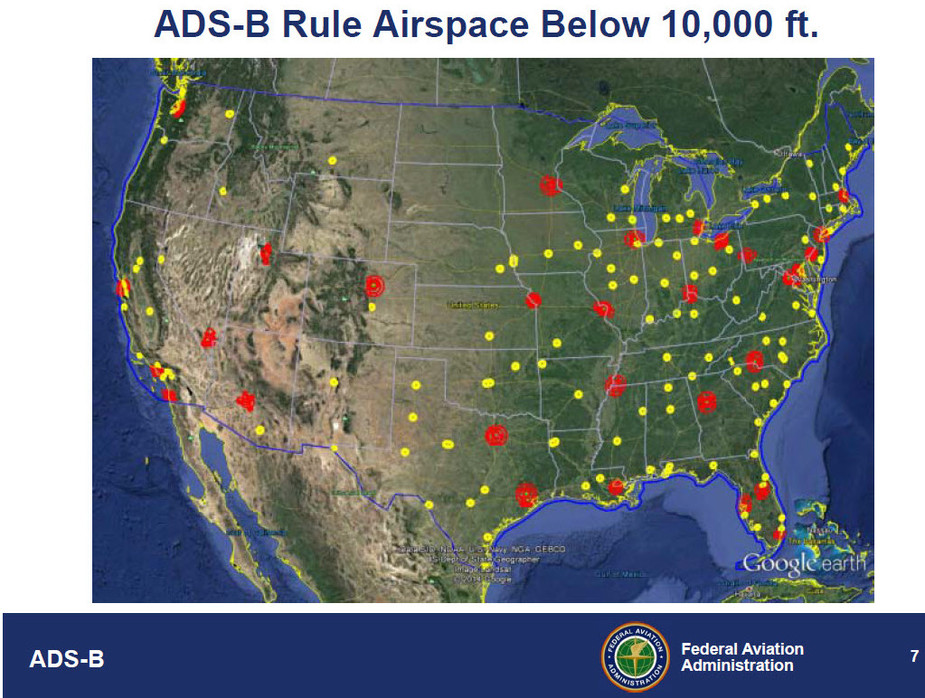dublinpilot wrote:
Are you saying that the 2020 date only applies to aircraft above 5700kt or with cruise speed exceeding 250kts?
According my interpretation yes, see this Eurocontrol link which includes references to the two regulations.
UAT will not die out. Outside of the US, no ground based services are offered. Inside the US. two ground based services are offered, TISB and FISB. FISB is the subscription free weather and only available on UAT. TISB is a service that the ground station broadcasts the mode A/C transponder positions of aircraft that are not ADS-B Out equipped. Equipped aircraft with ADS-B Out and ADS-B In will be able to display a fairly complete traffic picture by receiving other aircraft that are ADS-B Out equipped via air to air reception and non equipped aircraft via ground to air TISB to fill in most of the rest of the traffic. TISB is provided on 1090ES and UAT. I doubt that more than 70% of US aircraft will see the need to update to ADS-B Out and that TISB will be a useful service after 2020.
Here is a graphic showing all the airspace in the US that does not require ADS-B Out below 10,000 MSL. The red areas are Class B and the yellow areas are class C. If you remain clear of the red and yellow areas, ADS-B is not required below 10000 MSL. There are thousands of aircraft flown by pilots that never fly above 10000 MSL, never fly into a Class B or C airspace, and many of these aircraft owners will not see any reason to equip with ADS-B Out. On a one off basis, with an hours pre-notice, such an aircraft can request and obtain permission to fly into the Class B or C areas.

NCYankee wrote:
I doubt that more than 70% of US aircraft
The FAA mandate required ADS-B out for any aircraft that enters (most will get it – and the non-portable GPS/WAAS certified altitude source)::
Since the mandate is an airspace equipage requirement, many who never fly in the B and C airspace or at/above 10000 MSL, will see no need to update. Only 74% of US GA aircraft have mode C and another 16% with mode S, so that still leaves 10% that don’t have a transponder equipage to fly 10000 MSL/2500 AGL or B/C airspace after all these years. The cost will prevent many low end aircraft to avoid equipping as they won’t see a need to. If you fly in the NW US in ID, OR, NV, MT, CO, NE, ND, SD, MN there are large areas that don’t have ADS-B requirements. If you fly in an around the big cities, owners will equip, move, or sell their aircraft. It is going to be quite some time IMHO before the GA equipage gets above 70%.
NCYankee wrote:
Since the mandate is an airspace equipage requirement, many who never fly in the B and C airspace or at/above 10000 MSL, will see no need to update.
The current Mode C veil areas surrounding Class B airspace will also require ADS-B Out and are substantially larger than the Class B airspace itself, typically being 60 nm in diameter. A lot of light aircraft are based at Class E airports within the Mode C veils, outside of Class B or C airspace, and those aircraft will need ADS-B Out.
Thanks for posting the map – a picture is worth 1000 words. It looks like the Mode C Veil areas are correctly included but regardless, looking at the map its obvious that many people and planes in the US won’t need ADS-B Out. It’s certainly not going to be ‘mandatory’ to install ADS-B Out on US aircraft, and many US aircraft owners won’t even be aware of ADS-B for decades if ever, never mind needing it within the areas they fly.
Silvaire wrote:
It’s certainly not going to be ‘mandatory’ to install ADS-B Out on US aircraft
It is mandatory, it’s called the 2020 mandate. Those who want to fly around their farms don’t need a radio either…but we are talking about real aviation and real airspaces.
USFlyer wrote:
It is mandatory, it’s called the 2020 mandate. Those who want to fly around their farms don’t need a radio either…but we are talking about real aviation and real airspaces.
In the US, it is an airspace mandate, don’t fly in the airspace, no mandate. For the vast majority of the airspace in the US below 10,000 MSL, the mandate does not apply. Even in the airspace where the mandate applies, one can obtain permission to fly in the airspace, according to the regulation. I seriously doubt that aircraft will not be given permission on request. There is an exception for aircraft that don’t have an electrical system such as many Piper Cub, gliders, balloons, etc. They can fly in much of the airspace without a transponder or ADS-B Out.
While NCYankee’s map is very instructive, it’s also a little bit misleading. West of the Rockies, 10k ft MSL are very often only 2-3k ft AGL (or below AGL….). One does fly above that 10k level a lot out here. While I agree that the ADS-B mandate will be pretty irrelevant to many/most people flying in the ‘Heartland’, out West there isn’t really an option other than to equip your a/c with it.
PS: for those unfamiliar with FAA regs – the O2 carriage / usage only kicks in at 12.5k ft, so 10k is a non-O2 level here.
I only have an ICAO 5, but I believe:
2. Class E airspace within the 48 contiguous states and the District of Columbia at and above 10,000 feet MSL, excluding the airspace at and below 2,500 feet above the surface
would mean one can fly without ADS-B out in areas above 7501 ft MSL, but only to 2500 ft AGL.
(cited from the FAA: https://www.faa.gov/nextgen/programs/adsb/faq/#8